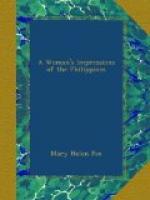The Bridge of Spain is approached from the Binondo side by almost the only steep grade to be found in Manila. I was leaning as far forward as I could, figuring upon the possible strain to be withstood by the frayed rope end which lay between us and a backward somersault, when my ears were assailed by an uncanny sound, half grunt, half moan. For an instant I thought it was the wretched pony moved to protest by the grade and my oppressive weight. But the pony was breasting the steep most gallantly, all things considered. The miserable sound was repeated a second later, just as our little four-footed friend struck the level, and I discovered that it was my driver’s appeal to his steed. It is a sound to move the pity of more than a horse; until you are thoroughly accustomed to it it leaves you under the apprehension that the cochero has been stricken with the plague. This habit of grunting at horses seems to be disappearing at the present time, the haughty customs of livery carromatas perhaps being responsible. Also English is spreading. Apart from swear words, which appear to fill a long-felt want for something emphatic, there are at least three phrases which every Filipino who has to do with horses seems to have made a part of his vocabulary. They are “Back!” “Whoa, boy!” and “Git up!” Your cochero may groan at your horse or whine at it, but when the need arises he can draw upon that much of English.
We jolted over the Bridge of Spain and through a masked gate into the walled city, with the wall on our left, and the high bricked boundaries of churches and conventos on the right, till we arrived at a low, square frame structure, with the words “Escuela Municipal” above its portals. In Spanish times it was the training-school for girls, and here temporary accommodation had been provided for us. We crossed a hall and a court where ferns and palms were growing, and were ushered into a room containing a number of four-poster beds. We were to obtain our food at a neighboring restaurant, whither we soon set out under guidance. The street was narrow, and all the houses had projecting second floors which overhung the sidewalk. Box-like shops on the ground floor were filled with cheap, unattractive-looking European wares, with here and there a restaurant displaying its viands, and attracting flies. We recognized the bananas and occasionally a pineapple, but the other fruits were new to us—lanzones in white, fuzzy clusters like giant grapes; the chico, a little brown fruit that tastes like baked apple flavored with caramel; and the atis, which most natives prise as a delicacy, but which few Americans ever learn to like.
We had been introduced to the alligator pear, the papaya, and the mango at Honolulu, but we were still expecting strange and wonderful gastronomic treats in our first Philippine meal.




